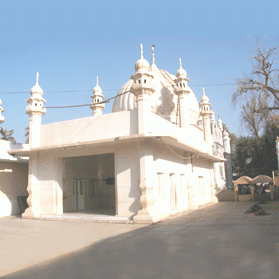
There are different views regarding the origin of the word ‘Sufi’. Some believe it is derived from ‘Suffa’ (platform), constructed in the (PBUH) time for devotees. The majority believe the word is derived from ‘sof’ meaning wool. During the eighth and ninth centuries, some ascetics were disturbed by the focus on wealth & materialism and the abandonment of austerity.
These ascetics tried to return to the simple life and dressed in coarse woolen garments that were supposedly favored by the Prophet (PBUH). Another view is that the word Sufi is derived from the term sahafa. In the times of the Holy Prophet Hazrat Mohammed (PBUH), the message of Islam was spreading far and wide by missionaries and conquests. The sahafa was one band of men who were totally devoted to prayer and meditation. Worship and search for spiritual perfection was their only aim. Over the centuries the sahafa became those holy men who are now called Sufis.
The French scholar Louis Massignon explains that social justice remained crucial to the ascetics piety (cited by K.Armstrong): ‘ The mystic call is as a rule the result of inner rebellion of the conscience against social injustices, not only those of others but primarily and particularly against one’s own faults with a desire intensified by inner purification to find God at any price.’ The Sufi’s initially shared a common vision with other sects. However, when the traditionalists started separating Islam from other religions as being the only true faith, the Sufi’s preached the unity of all ‘rightly guided religion’ (Armstrong). Rabiah (early woman ascetic, d. 801) wrote this prayer that reflected the Sufi’s views:
“ O God! If I worship thee in fear of Hell, burn me in Hell; And if I worship thee in hope of Paradise, exclude me from Paradise; But if I worship Thee for Thine sake, withhold not Thine Everlasting Beauty!”
Sindh is known as ‘the land of 124,000 saints, both Muslim and Hindu. The Sufi saints have a large following among Muslims and Hindus of every stratum. A number of Hindus come from all parts of the world for the mela at Jalalani Sharif. There is no place for religious differences among Sufis- and hasn’t been since the centuries old link between the people of Sindh and Sufism. Sufism has no room for fundamentalism or fanaticism because it has challenged the institution of the ‘mullah’ (Muslim cleric). Some crossover exists with some Hindu customs such as taking ‘naam’ from a Guru or Murshid, bowing down to touch the Guru’s feet, Dakshana or ‘nazrana’ to the Guru and going inside the temple or dargah (tomb) and bowing down as a sign of respect. Fasting however is common to many religions including Hindusim, Islam, Christianity etc.
This spiritualism offers a world without sectarian, ethnic and communal difference. It is due to this hold of mysticism on Sindhi culture, that there are hardly any religious or sectarian conflicts in the vicinity of the Sufi Dargah’s as compared to other parts of Pakistan. Sufi’s have over the centuries played a significant role in the evolution of techniques and disciplines that have influenced mystics in all religions achieve a higher state of consciousness. For example the practices of fasting for ten (Daha) or forty (Chalihya) days, staying up for meditation at night (Jago), and repetition of God’s name as a Mantra are all contributions made by the Sufi’s. Karen Armstrong points out “ Unlike dogmatic religion, which lends itself to sectarian disputes, mysticism often claims that there are as many roads to God as people. Sufism in particular would evolve an outstanding appreciation of the faith of others.” According to S.A.A. Rizvi, Shaikh Abdul Rehman Chisti (1683) the Sufi interpreter of the Bhagawad Gita remarks the central part of Krishna’s teaching is illustrated in this verse:
“O Arjuna whatever you do consider Him as Its author associate none with them and Be assured that all is He that is one and no partner”
It is Mohammed Qutbi’s opinion that there are conspicuous similarities between the doctrine of the Unity of being as stated by people like Ibne Arabi and the Vedantic philosophy.
In the Western world today diverse groups exist under the name of Sufism. On the one hand there are those who would say that no true Sufism can exist without appreciation and practice of the principles of Islam. On the other hand some groups exist that more or less ignore the Islamic roots of Sufism and take their teaching from further downstream, from “Sufis” who may or may not have had contact with specifically Islamic teachings.
DEFINITION
Arberry defines Sufism as ‘the mystical movement of an uncompromising Monotheism.’
PILLARS OF SUFISM
- FANA. The doctrine of passing away or merging with God (Fana) is a central issue in the structure of Sufi theory.
- TAWAKKUL. Trust in God.
- YAKIN. Faith in God.
- FIKR. This refers to reflection and contemplation on the Truth.
- SHUKR. Thankfulness.
- MURAQBA. Constant awareness of God. This term is probably derived from ‘raqib’ or a watchman and refers to the desirability of contemplating the attributes of God or the life hereafter.
- ZIKR. Remembrance through repetition of God’s name. Perception of the truth is the object of all meditation and is known by various names in different religions. The Hindu religion calls it ‘nirvana’, the Christians call it ‘via illuminativa’ and the Sufi’s call it ‘maarifa’. Zikr is done silently (khafi) or loudly (jali). The Sufi finds great pleasure in repeating God’s name, as there cannot be any ritual dearer for lovers than constant repetition of the beloved’s name. During Zikr, concentration is aimed at 6 subtle points in the body. They are: Nafs (lower soul): the location is near the navel, the light (nur) generated through concentration on this point is said to be earth colored. alb (heart): located at the left side, just below the heart, the color of the nur is yellow. Ruh (spirit): the location is at the right side a little below the breast; the color of the nur is red. Sirr (interior of the heart): located just above the Qalb, light generated is said to be white. Khafi (inner most secret): located just above the point of ruh, and the nur produced is black. and akhfa (veiled from observation): located at the center of the brain and the color of the nur is green.
- MURSHID & MUREED. Concept of a spiritual teacher (Murshid) and the disciple (Mureed).
- Instructions said in verse for the mureed or follower
- Verses said in admiration and love of Murshid
- Verses expressing mureed’s own feelings
VARIOUS SUFI ORDERS
- Muhyi Din Abdul Al-Qadri (Al-Jilani or Qadria)
- Suhrawardiya
- Chisthia
- Naqshbandia
BOOKS ON SUFISM
- 1. Arberry, A.J. (1963). Sufism. Allen & Irwin: London.
- 2. Qutbi, M.M.A. (1993). Fragrance of Sufism. Royal Book Company: Karachi, Pakistan.
- 3. Armstrong, K. (1994). A history of God. Alfred A. Knopf: New York.
